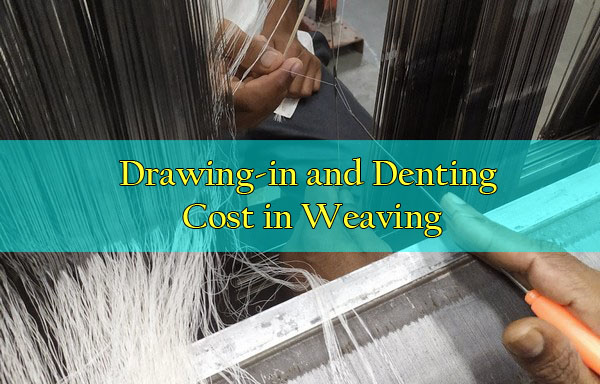What is Drawing-in and Denting?
Drawing-in and denting are the intermediate operations performed after sizing operation and before the weaving process. Drawing in is the process of entering the individual yarn of warp sheet through dropper, heald eye and the reed dent. The yarns can be threaded wither manually or by using automatic machines. The main objective of the drawing in is leasing the warp yarn from weavers beam (prepared in the sizing operation), drawing the yarn in heald shaft, tying and inserting individual warp yarn into the dropper-pin for weaving process. The operations in turn depend on different types of yarn, weaving machine type, and method of production planned in weaving.

In general, the drawing in operation is performed manually and it is more of skill oriented and so requires very skilled operatives. However, the advancements in the sector also brought semi-automatic and automatic mechanized devices in this process. But hand drawing in is the most widely adapted method still.
Similarly, the denting is a process of inserting single or a pair of warp threads into the reed dents by means of dent hook. The operation is repeated until all the ends of the bunch have been drawn in. On the other side of the reed, the free ends are knotted together. Except for a frame to fix the heald shaft, the operation requires no other capital investment. It requires two persons to carry out this operation, where one finds the individual ends from the weaver’s beam and gives it to the other person, who in turn draws the same through the appropriate heald eye, drop pins and dent spacing.
An efficient operator can draw-in approximately 1500 – 2000 warp ends per hour in the heald shaft and dent it in the reed for a plain weave. They can supply 45-50 looms based on the number of ends in a weavers beam. The picks per inch are the deciding factor for the production.
Production Cost Calculation in Denting and Drawing-in Section:
In this section, the only factor involved in the production is skilled manpower to perform the operation. The cost associated with this process is labor cost. In some case, if the drawing-in pattern in not understood by the operator, the process may slow down due to the design repeat size and it will increase the cost by delaying in the production speed.
Factors Influencing the Cost of Drawing-in and Denting in Weaving:
- Operator experience and training
- Weave design complication and color pattern
- Cleanness of the heald shafts and reed
- Yarn count
- Mistakes made by the operators
- Use of machines
Cost Calculation in Drawing-in and Denting Process in Weaving:
- In general, the cost of drawing-in and denting process is the cost of labor used in the process.
- In practical aspects, the cost is estimated for the process based on the number of ends to be drawn – in and dented.
- The knotting process is the process of knotting/attaching the warp yarn into the previously completed yarn end of the weaving machine. It is also associated with this activity.
- The cost of drawing-in and denting process roughly vary between Tk. 0.10 – Tk. 0.30 per end.
- Similarly, the cost of knotting varies from Tk. 0.05 – Tk. 0.20 per end.
Conclusion:
Drawing-in and denting operation in weaving is crucial for fabric production. By considering factors such as labor, materials, and machine time, weavers can better manage expenses and optimize production. Implementing systematic methods for cost calculation not only enhances financial planning but also improves overall productivity.
References:
- Handbook of Textile and Apparel Costing by Dr. R. Rathinamoorthy, Dr. R. Surjit and Dr. K. J.Vishnu Vardhini
- Handbook on Fabric Manufacturing: Grey Fabrics: Preparation, Weaving to Marketing by B. Purushothama
- Textile Engineering – An Introduction Edited by Yasir Nawab
